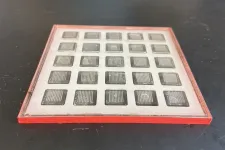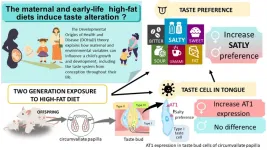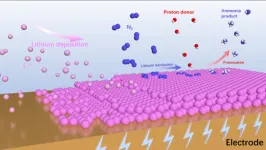(Press-News.org) CAMBRIDGE, MA -- Getting vaccines to people who need them isn’t always easy. Many vaccines require cold storage, making it difficult to ship them to remote areas that don’t have the necessary infrastructure.
MIT researchers have come up with a possible solution to this problem: a mobile vaccine printer that could be scaled up to produce hundreds of vaccine doses in a day. This kind of printer, which can fit on a tabletop, could be deployed anywhere vaccines are needed, the researchers say.
“We could someday have on-demand vaccine production,” says Ana Jaklenec, a research scientist at MIT’s Koch Institute for Integrative Cancer Research. “If, for example, there was an Ebola outbreak in a particular region, one could ship a few of these printers there and vaccinate the people in that location.”
The printer produces patches with hundreds of microneedles containing vaccine. The patch can be attached to the skin, allowing the vaccine to dissolve without the need for a traditional injection. Once printed, the vaccine patches can be stored for months at room temperature.
In a study appearing today in Nature Biotechnology, the researchers showed they could use the printer to produce thermostable Covid-19 RNA vaccines that could induce a comparable immune response to that generated by injected RNA vaccines, in mice.
Jaklenec and Robert Langer, the David H. Koch Institute Professor at MIT and a member of the Koch Institute, are the senior authors of the study. The paper’s lead authors are former MIT postdoc Aurelien vander Straeten, former MIT graduate student Morteza Sarmadi ’21, and postdoc John Daristotle.
Printing vaccines
Most vaccines, including mRNA vaccines, have to be refrigerated while stored, making it difficult to stockpile them or send them to locations where those temperatures can’t be maintained. Furthermore, they require syringes, needles, and trained health care professionals to administer them.
To get around this obstacle, the MIT team set out to find a way to produce vaccines on demand. Their original motivation, before Covid-19 arrived, was to build a device that could quickly produce and deploy vaccines during outbreaks of diseases such as Ebola. Such a device could be shipped to a remote village, a refugee camp, or military base to enable rapid vaccination of large numbers of people.
Instead of producing traditional injectable vaccines, the researchers decided to work with a novel type of vaccine delivery based on patches about the size of a thumbnail, which contain hundreds of microneedles. Such vaccines are now in development for many diseases, including polio, measles, and rubella. When the patch is applied to the skin, the tips of the needles dissolve under the skin, releasing the vaccine.
“When Covid-19 started, concerns about vaccine stability and vaccine access motivated us to try to incorporate RNA vaccines into microneedle patches,” Daristotle says.
The “ink” that the researchers use to print the vaccine-containing microneedles includes RNA vaccine molecules that are encapsulated in lipid nanoparticles, which help them to remain stable for long periods of time.
The ink also contains polymers that can be easily molded into the right shape and then remain stable for weeks or months, even when stored at room temperature or higher. The researchers found that a 50/50 combination of polyvinylpyrrolidone and polyvinyl alcohol, both of which are commonly used to form microneedles, had the best combination of stiffness and stability.
Inside the printer, a robotic arm injects ink into microneedle molds, and a vacuum chamber below the mold sucks the ink down to the bottom, making sure that ink reaches all the way to the tips of the needles. Once the molds are filled, they take a day or two to dry. The current prototype can produce 100 patches in 48 hours, but the researchers anticipate that future versions could be designed to have higher capacity.
Antibody response
To test the long-term stability of the vaccines, the researchers first created an ink containing RNA that encodes luciferase, a fluorescent protein. They applied the resulting microneedle patches to mice after being stored at either 4 degrees Celsius or 25 degrees Celsius (room temperature) for up to six months. They also stored one batch of the particles at 37 degrees Celsius for one month.
Under all of these storage conditions, the patches induced a strong fluorescent response when applied to mice. In contrast, the fluorescent response produced by a traditional intramuscular injection of the fluorescent-protein-encoding RNA declined with longer storage times at room temperature.
Then, the researchers tested their Covid-19 microneedle vaccine. They vaccinated mice with two doses of the vaccine, four weeks apart, then measured their antibody response to the virus. Mice vaccinated with the microneedle patch had a similar response to mice vaccinated with a traditional, injected RNA vaccine.
The researchers also saw the same strong antibody response when they vaccinated mice with microneedle patches that had been stored at room temperature for up to three months.
“This work is particularly exciting as it realizes the ability to produce vaccines on demand,” says Joseph DeSimone, a professor of translational medicine and chemical engineering at Stanford University, who was not involved in the research. “With the possibility of scaling up vaccine manufacturing and improved stability at higher temperatures, mobile vaccine printers can facilitate widespread access to RNA vaccines.”
While this study focused on Covid-19 RNA vaccines, the researchers plan to adapt the process to produce other types of vaccines, including vaccines made from proteins or inactivated viruses.
“The ink composition was key in stabilizing mRNA vaccines, but the ink can contain various types of vaccines or even drugs, allowing for flexibility and modularity in what can be delivered using this microneedle platform,” Jaklenec says.
Other authors of the paper are Maria Kanelli, Lisa Tostanoski, Joe Collins, Apurva Pardeshi, Jooli Han, Dhruv Varshney, Behnaz Eshaghi, Johnny Garcia, Timothy Forster, Gary Li, Nandita Menon, Sydney Pyon, Linzixuan Zhang, Catherine Jacob-Dolan, Olivia Powers, Kevin Hall, Shahad Alsaiari, Morris Wolf, Mark Tibbitt, Robert Farra, and Dan Barouch.
###
The research was funded by the Biomedical Advanced Research and Development Authority (BARDA), the Belgian American Educational Foundation, Wallonia-Brussels International, the Bodossaki Foundation, the Onassis Foundation, the National Institutes of Health, and the Koch Institute Support (core) Grant from the National Cancer Institute.
END
Vaccine printer could help vaccines reach more people
The printer generates vaccine-filled microneedle patches that can be stored long-term at room temperature and applied to the skin
2023-04-24
ELSE PRESS RELEASES FROM THIS DATE:
Scientists have full state of a quantum liquid down cold
2023-04-24
A team of physicists has illuminated certain properties of quantum systems by observing how their fluctuations spread over time. The research offers an intricate understanding of a complex phenomenon that is foundational to quantum computing—a method that can perform certain calculations significantly more efficiently than conventional computing.
“In an era of quantum computing it’s vital to generate a precise characterization of the systems we are building,” explains Dries Sels, an assistant ...
Massive iceberg discharges during the last ice age had no impact on nearby Greenland, raising new questions about climate dynamics
2023-04-24
CORVALLIS, Ore. – During the last ice age, massive icebergs periodically broke off from an ice sheet covering a large swath of North America and discharged rapidly melting ice into the North Atlantic Ocean around Greenland, triggering abrupt climate change impacts across the globe.
These sudden episodes, called Heinrich Events, occurred between 16,000 and 60,000 years ago. They altered the circulation of the world’s oceans, spurring cooling in the North Atlantic and impacting monsoon rainfall around the world.
But ...
New biologic effective against major infection in early tests
2023-04-24
Researchers at NYU Grossman School of Medicine and Janssen Biotech, Inc. have shown in early tests that a bioengineered drug candidate can counter infection with Staphylococcus aureus – a bacterial species widely resistant to antibiotics and a major cause of death in hospitalized patients.
Experiments demonstrated that SM1B74, an antibacterial biologic agent, was superior to a standard antibiotic drug at treating mice infected with S. aureus, including its treatment-resistant form known as MRSA.
Published ...
Researchers develop new tools for precise large DNA insertions
2023-04-24
GAO Caixia's group from the Institute of Genetics and Developmental Biology of the Chinese Academy of Sciences (CAS) has developed a new genome editing technology that achieves efficient and precise targeted insertion of large DNA segments in plants.
The new technology, called prime editing-mediated recombination of opportune targets (PrimeRoot), combines an optimized dual-ePPE editor protein previously published by the group with a highly efficient tyrosine site-specific recombinase, Cre. It can achieve ...
Researchers ID novel treatment pathway for deadly pancreatic cancers
2023-04-24
Researchers at the Johns Hopkins Kimmel Cancer Center identified a novel cell signaling pathway that potentially could be targeted in therapy for patients with aggressive pancreatic cancers.
In laboratory studies with human pancreatic cancer cell lines and genetically engineered mouse models of pancreatic cancer, the investigators discovered that the High Mobility Group A1 (HMGA1) protein functions as a “molecular switch” that “flips on” genes required by tumor cells to grow in an uncontrolled fashion and form invasive tumors. One of these genes activated ...
Maternal and early-life high-fat diets result in a taste for salty food
2023-04-24
Tokyo, Japan – We are all aware of the importance of eating healthy food, especially during pregnancy. A high-fat diet has dramatic consequences on the metabolism. It can lead to obesity, diabetes, chronic liver disease, and possibly cancer. Previous works have demonstrated that eating high amounts of fat during pregnancy affects the taste preference and metabolism in offspring. In most households, children and parents eat the same food. In other words, mums eating a high-fat diet will likely feed their children fatty foods. What are the consequences of maternal ...
NFL PLAY 60 Fitness Break broadcast keeps kids active in advance of the NFL Draft
2023-04-24
DALLAS, April 24, 2023 — The American Heart Association and the National Football League (NFL), in collaboration with its 32 NFL clubs, are challenging kids to move more with an NFL PLAY 60 Fitness Break for the NFL Draft happening later this week. The free program on Wednesday, April 26 at 1 p.m. ET/ 12 p.m. CT/ 10 a.m. PT will offer a 15-minute synchronous broadcast to help students learn how to add movement to their day leading up to the live Draft coverage from Kansas City.
Rooted in American Heart Association science, the Fitness Break broadcast helps students learn more about how physical activity supports ...
A panoramic view on lithium-mediated electrochemical dinitrogen reduction reaction
2023-04-24
The Haber-Bosch process is the industrial approach for NH3 production today, which must be operated at energy-intensive high temperatures and pressures. The reduction of dinitrogen (N2) by electrocatalysis offers an alternative way for NH3 production at ambient conditions and a variety of electrocatalysts have been studied over the past few years. However, even the best catalytic system reported could only get unsatisfied performance (such as the selectivity and production rate of NH3) due to the ...
Unveiling a fast and efficient method for detecting microRNAs
2023-04-24
In the early 1990s, scientists who were studying the development of a roundworm identified a small RNA molecule that regulated the expression of specific genes. This marked the discovery of microRNAs (miRNAs), which are now known to be present across all forms of life. As it turns out, these molecules play essential roles in many biological processes.
A few years later, researchers realized that diseases could dysregulate the expression of miRNAs, highlighting their potential as biomarkers. In fact, abnormal miRNA expression is a hallmark of all tumor-related diseases. Thus, miRNA detection techniques ...
Research sheds light on minimally invasive neurosurgery approach
2023-04-24
Brain tumors located in regions that control speech, vision and motor function present additional challenges to neurosurgeons, as damaging the surrounding tissue can cause severe loss of those abilities.. Because of this, these regions are known as “eloquent brain areas” and require special attention and approaches to limit damage and deficits.
The University of Cincinnati’s Paolo Palmisciano, MD, was part of a research team that examined how well a minimally invasive approach worked to limit vision and hearing loss in patients following brain tumor surgery.
The research was published in the journal Brain Sciences, and the ...
LAST 30 PRESS RELEASES:
Boosting the cell’s own cleanup
Movement matters: Light activity led to better survival in diabetes, heart, kidney disease
Method developed to identify best treatment combinations for glioblastoma based on unique cellular targets
Self-guided behavioral app helps children with epilepsy sleep earlier
Higher consumption of food preservatives is associated with an increased risk of type 2 diabetes
NTU Singapore-led team captures first-ever ‘twitch’ of the eye’s night-vision cells as they detect light, paving the way for earlier detection of blindness-causing diseases
Global aviation emissions could be halved through maximising efficiency gains, new study shows
Fewer layovers, better-connected airports, more firm growth
Exposure to natural light improves metabolic health
As we age, immune cells protect the spinal cord
New expert guidance urges caution before surgery for patients with treatment-resistant constipation
Solar hydrogen can now be produced efficiently without the scarce metal platinum
Sleeping in on weekends may help boost teens’ mental health
Study: Teens use cellphones for an hour a day at school
After more than two years of war, Palestinian children are hungry, denied education and “like the living dead”
The untold story of life with Prader-Willi syndrome - according to the siblings who live it
How the parasite that ‘gave up sex’ found more hosts – and why its victory won’t last
When is it time to jump? The boiling frog problem of AI use in physics education
Twitter data reveals partisan divide in understanding why pollen season's getting worse
AI is quick but risky for updating old software
Revolutionizing biosecurity: new multi-omics framework to transform invasive species management
From ancient herb to modern medicine: new review unveils the multi-targeted healing potential of Borago officinalis
Building a global scientific community: Biological Diversity Journal announces dual recruitment of Editorial Board and Youth Editorial Board members
Microbes that break down antibiotics help protect ecosystems under drug pollution
Smart biochar that remembers pollutants offers a new way to clean water and recycle biomass
Rice genes matter more than domestication in shaping plant microbiomes
Ticking time bomb: Some farmers report as many as 70 tick encounters over a 6-month period
Turning garden and crop waste into plastics
Scientists discover ‘platypus galaxies’ in the early universe
Seeing thyroid cancer in a new light: when AI meets label-free imaging in the operating room
[Press-News.org] Vaccine printer could help vaccines reach more peopleThe printer generates vaccine-filled microneedle patches that can be stored long-term at room temperature and applied to the skin









